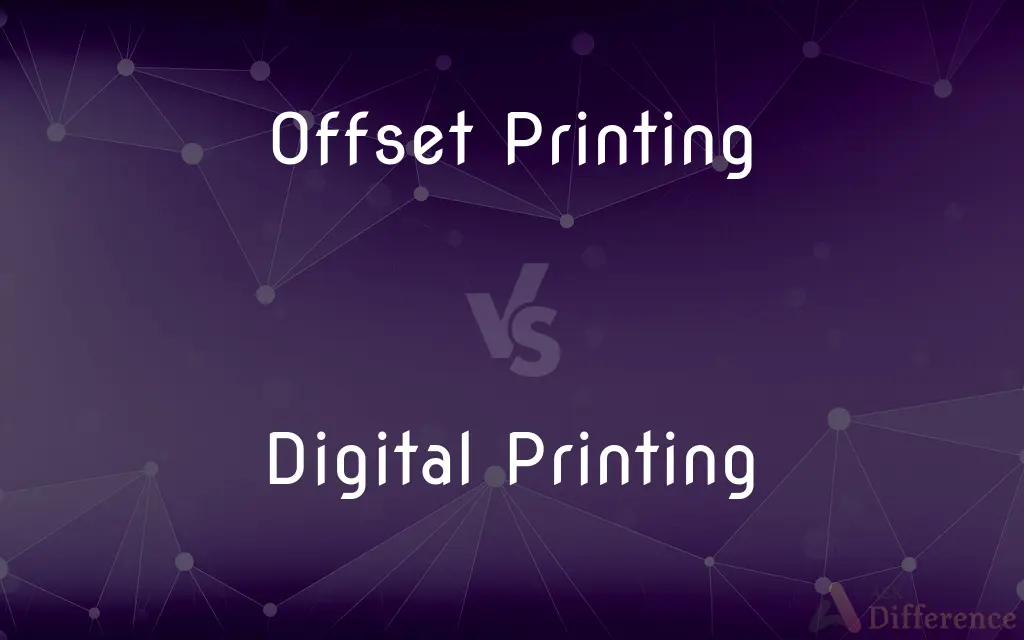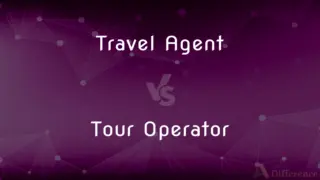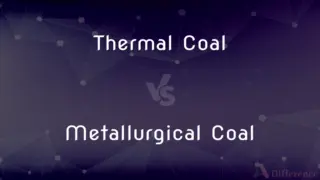Offset Printing vs. Digital Printing — What's the Difference?
By Tayyaba Rehman & Fiza Rafique — Published on March 26, 2024
Offset printing excels in large-volume, high-quality print jobs with color accuracy, while digital printing offers flexibility, shorter turnaround times, and cost-effectiveness for small runs.

Difference Between Offset Printing and Digital Printing
Table of Contents
ADVERTISEMENT
Key Differences
Offset printing, a traditional method, uses plates to transfer images onto a rubber blanket and then to the printing surface. This technique is renowned for its exceptional quality and color accuracy, making it ideal for large print runs where consistency is key.
Digital printing, on the other hand, eliminates the need for printing plates, directly printing images onto the material. This method allows for easy customization, making it perfect for small to medium runs, variable data printing, and on-demand printing needs.
In terms of cost, offset printing involves higher setup costs due to the plates, making it less economical for small runs. However, its cost per unit decreases significantly with volume, becoming more cost-effective for large quantities. Digital printing offers a lower initial cost and remains relatively constant, making it more suitable for smaller quantities.
The choice between offset and digital printing often depends on the project's specifics, including quantity, turnaround time, and color requirements. Offset is preferred for larger runs requiring high fidelity and specific colors, such as Pantone shades, while digital is favored for its flexibility and efficiency in short runs or projects with variable data.
Both printing methods have their unique advantages, with offset providing unparalleled quality and efficiency for large volumes, and digital offering versatility and cost savings for smaller, customized projects. Understanding the strengths and requirements of each can help in choosing the most appropriate method for any printing task.
ADVERTISEMENT
Comparison Chart
Setup Cost
High (due to plates)
Low (no plates required)
Cost per Unit
Decreases with volume
Relatively constant
Print Quality
High quality and color accuracy
Good quality with slight variations
Customization
Limited
High (easy to customize)
Turnaround Time
Longer (due to setup)
Shorter (direct printing process)
Ideal for
Large runs, specific colors
Small to medium runs, variable data
Color Matching
Excellent (Pantone matching)
Good (CMYK, close to Pantone)
Material Variety
Wide range
More limited compared to offset
Compare with Definitions
Offset Printing
Ideal for large-volume printing.
Thousands of brochures are cost-effectively printed using offset.
Digital Printing
Offers quick turnaround times.
Digital printing can produce marketing flyers within a day.
Offset Printing
Involves a longer setup time.
Setting up plates for an offset print job can take several hours.
Digital Printing
Enables variable data printing.
Each piece can have different text or images, such as addresses on postcards.
Offset Printing
Offers precise color matching.
Offset printing is used for brand materials requiring exact Pantone colors.
Digital Printing
Flexibility in print materials.
Digital printers can handle a variety of paper types and sizes easily.
Offset Printing
Offset printing uses plates for image transfer, ensuring high-quality outputs.
Business cards printed via offset have consistent colors.
Digital Printing
Digital printing prints directly from a digital file, suitable for short runs.
A small batch of personalized invitations is printed digitally.
Offset Printing
More cost-effective in bulk.
The more copies you print, the cheaper each page becomes with offset printing.
Digital Printing
Lower initial costs for small quantities.
Printing a few dozen booklets is cheaper with digital methods.
Common Curiosities
Can digital printing match colors as well as offset printing?
While digital printing provides good color quality, offset printing offers superior color matching, especially for specific Pantone colors.
Can I use digital printing for large volumes?
While possible, digital printing may not be as cost-effective or consistent in quality for very large volumes compared to offset printing.
Which is faster, offset or digital printing?
Digital printing offers faster turnaround times, especially for small to medium runs.
Is there a break-even point for choosing between offset and digital printing?
Yes, this point depends on specific project details, but generally, larger volumes favor offset, while smaller quantities benefit from digital printing.
Is digital printing more environmentally friendly than offset?
Digital printing tends to be more eco-friendly, with less waste and no need for plates or chemicals used in offset printing.
Why choose offset printing if digital is quicker and cheaper for small runs?
Offset printing is preferred for its superior quality, color accuracy, and cost-effectiveness in large quantities.
Can offset printing handle different paper sizes and types?
Yes, offset printing can accommodate a wide range of materials, often wider than digital options.
How do setup costs affect the overall cost of a print job?
For offset printing, high initial setup costs mean larger runs are more economical per unit. Digital printing has lower setup costs, making it cost-effective for smaller runs.
How does the print quality compare between the two methods?
Offset printing generally offers better quality and consistency, especially for large runs, but digital printing quality has significantly improved and is sufficient for many applications.
Which method is better for personalized printing?
Digital printing is the better option for personalized or variable data printing due to its direct-from-file printing capability.
Share Your Discovery

Previous Comparison
Travel Agent vs. Tour Operator
Next Comparison
Thermal Coal vs. Metallurgical CoalAuthor Spotlight
Written by
Tayyaba RehmanTayyaba Rehman is a distinguished writer, currently serving as a primary contributor to askdifference.com. As a researcher in semantics and etymology, Tayyaba's passion for the complexity of languages and their distinctions has found a perfect home on the platform. Tayyaba delves into the intricacies of language, distinguishing between commonly confused words and phrases, thereby providing clarity for readers worldwide.
Co-written by
Fiza RafiqueFiza Rafique is a skilled content writer at AskDifference.com, where she meticulously refines and enhances written pieces. Drawing from her vast editorial expertise, Fiza ensures clarity, accuracy, and precision in every article. Passionate about language, she continually seeks to elevate the quality of content for readers worldwide.













































